Aerospace Micro-Lesson #87
In This Section
Apollo 11: The First Manned Moon Landing
On Wednesday, July 16, 1969, a Saturn V rocket blasted off from Cape Canaveral in Florida. It was the sixth flight of a Saturn V, the third mission that sent men toward the Moon, and the first mission actually to land people on the Moon. Four days later, on the afternoon of July 20, Neil Armstrong and Edwin (“Buzz”) Aldrin landed the Lunar Module in the Sea of Tranquility on the Moon. (It was “mid-morning” in the Sea of Tranquility’s four-week “day,” though; July 20 was two days before the Moon’s first quarter—sunrise at zero degrees longitude—and the landing site was at a longitude of 20 degrees east.) Six hours later, Armstrong and Aldrin walked on the Moon, and after less than an Earth day on its surface they blasted off to come home.
With all the remembrances surrounding the fiftieth anniversary of an event that was literally unprecedented in history, this micro-lesson runs a real danger of being swallowed up in the general clamor or simply of echoing information that is readily available elsewhere. Nevertheless, to ignore the Moon landing on this anniversary would be criminal. The emphasis of this lesson, then, will be on isolated aspects of the Apollo 11 mission rather than a simple recounting of the mission itself.
GRADES K–2
Most people can name Neil Armstrong and Buzz Aldrin as the astronauts from the Apollo 11 mission who walked on the moon. But ask them to name their crewmate, the one patiently circling the moon and waiting for them to make the ascent and rejoin him for the trip back to earth and many can’t recall his name. Michael Collins was the command module pilot for the mission, staying on board the Columbia while Armstrong and Aldrin landed on the moon in the Eagle, and then lifted from the lunar surface to rendezvous with the Columbia for the trip home.
As Collins monitored the instruments in the command module, waiting for the completion of the lunar landing and the ascent of the Eagle, he was completely alone in the spacecraft. Each time the Columbia orbited around the far side of the moon he lost communication with ground control and his teammates; he was completely isolated. “I am alone now, truly alone, and absolutely isolated from any known life. I am it. If a count were taken, the score would be three billion plus two over on the other side of the moon, and one plus God knows what on this side," he wrote. According to an interview with The Guardian in July 2009, he felt a sort of exultation rather than loneliness during those hours alone.
Being so far from home and without companions, or even the sight of Earth at times, he experienced an isolation that had never been humanly possible before. Even the teams that had circled the moon on previous Apollo missions had done so together, and had companions when they were out of sight and sound of Earth. Collins’ experience was unique - although another pioneer empathized with him and wrote to him after the mission. Pilot Charles Lindbergh, who was the first person to fly an airplane across the Atlantic Ocean by himself, likened those hours in the command module to his own time over the Atlantic and wrote to Collins, “You have experienced an aloneness unknown to man before. I believe you will find that it lets you think and sense with a greater clarity.”
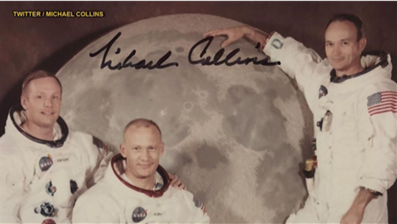 In June, Collins tweeted out this photo, saying, “Found this at the bottom of a box. Don’t think it was ever used by @NASA.” The image shows Collins by himself to one side of the frame, while Armstrong and Aldrin are together on the other side, oddly mirroring their separation during the mission.
In June, Collins tweeted out this photo, saying, “Found this at the bottom of a box. Don’t think it was ever used by @NASA.” The image shows Collins by himself to one side of the frame, while Armstrong and Aldrin are together on the other side, oddly mirroring their separation during the mission.
The two astronauts on the Moon were supposed to sleep between the landing and stepping out on the Moon but were too excited to sleep, so they stepped out early. Collins was nervous, too, worrying about the untested ascent engines of the Eagle and whether it would bring his crewmates safely back up from the surface. Luckily, everything went as planned and all three returned to Earth. Collins went on to serve as Assistant Secretary of State for Public Affairs, as Director of the National Air and Space Museum, and as an aerospace consultant. He also wrote an autobiography, Carrying the Fire: An Astronaut’s Journeys, which is for adult readers, and Flying to the Moon: An Astronaut’s Story which is for younger readers.
GRADES 3–5
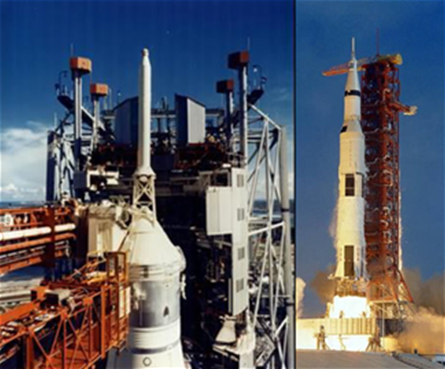 You have probably seen a small model rocket launch; perhaps you have launched one yourself. Model rockets are a foot long, perhaps a bit longer, perhaps one to three inches in diameter, and can launch themselves and a very light payload some tens to hundreds of feet high. To launch a larger payload or to go higher, you need to use a bigger rocket. The reason for this is that to get the payload to the higher altitude, first you need to get the payload to the lower altitude—along with the rocket that will carry it higher. A sounding rocket that flies tens of miles up into the atmosphere is 10-20 feet long and perhaps a foot or two in diameter. A Delta rocket, which can launch a car-sized satellite into Earth orbit, is 125 feet high and eight feet in diameter. (It takes much more fuel to send a payload into orbit than it does simply to send it up into space because the rocket needs to get the payload moving fast enough that it will not come back down but will actually circle the Earth.) To launch the Apollo 11 astronauts to the Moon took a Saturn V rocket, which stood 363 feet tall and 33 feet in diameter at its base (without its tail fins).
You have probably seen a small model rocket launch; perhaps you have launched one yourself. Model rockets are a foot long, perhaps a bit longer, perhaps one to three inches in diameter, and can launch themselves and a very light payload some tens to hundreds of feet high. To launch a larger payload or to go higher, you need to use a bigger rocket. The reason for this is that to get the payload to the higher altitude, first you need to get the payload to the lower altitude—along with the rocket that will carry it higher. A sounding rocket that flies tens of miles up into the atmosphere is 10-20 feet long and perhaps a foot or two in diameter. A Delta rocket, which can launch a car-sized satellite into Earth orbit, is 125 feet high and eight feet in diameter. (It takes much more fuel to send a payload into orbit than it does simply to send it up into space because the rocket needs to get the payload moving fast enough that it will not come back down but will actually circle the Earth.) To launch the Apollo 11 astronauts to the Moon took a Saturn V rocket, which stood 363 feet tall and 33 feet in diameter at its base (without its tail fins).
The highest natural point in the state of Florida reaches a whopping 345 feet above sea level and is located at Britton Hill, near the Alabama state line. So at about 300 feet above the ground, the walkway that the astronauts used to get into the Apollo capsule was almost as high as the highest natural point in the whole state of Florida. The entire launch tower was 402 feet high.
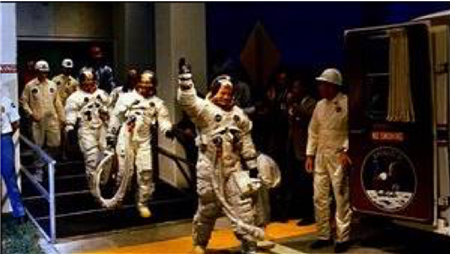 If you have ever built something that is very long and thin and then tried to stand it up on its end, you know just how difficult that last step can be. Unless you support the thing at just about every point along its length, it can fall apart on you. NASA would have had the same problem when they were assembling the Saturn V rocket.
If you have ever built something that is very long and thin and then tried to stand it up on its end, you know just how difficult that last step can be. Unless you support the thing at just about every point along its length, it can fall apart on you. NASA would have had the same problem when they were assembling the Saturn V rocket.
NASA’s solution to the problem was to assemble the Saturn V rocket already standing vertically on its end. They built a gigantic building called the Vehicle Assembly Building, or VAB, at Cape Canaveral in which they could assemble rockets. The VAB is 525 feet tall and has doors that are 456 feet tall, tall enough to fit the Saturn V and its support tower—and the crawlers that carried the Saturn V from the VAB to the launch pad. Assembling the rocket in the building meant that NASA did not have to worry about a half-assembled rocket being damaged by rain or tipped over by a strong wind. NASA still uses the VAB and the crawlers to assemble rockets and carry them out to the launch pad.
GRADES 6–8
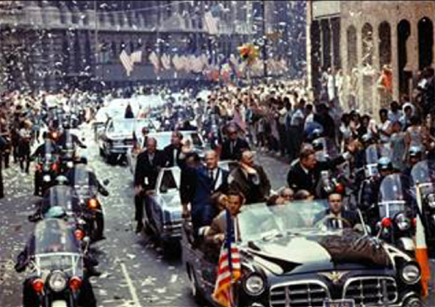 Apollo 11 completed the task set by President Kennedy in his speech from May 1961, that before the decade was over the United States would have a man land on the moon and safely return to Earth. Along with fulfilling that dream, other objectives for Apollo 11 included “deployment of a television camera to transmit signals to Earth; and deployment of a solar wind composition experiment, seismic experiment package and a Laser Ranging Retroreflector.” The solar wind experiment was a piece of foil that was exposed on the Moon’s surface and then returned to Earth so scientists could examine the particles that had embedded themselves in it. The seismic experiment detected “moonquakes” and the vibrations caused by meteoroid impacts. The Laser Ranging Retroreflector was a “corner reflector” of three mirrors arranged perpendicular to each other that reflects a laser beam directly back in the direction it came from—no matter what that direction is, as long as it is within the correct octant. Scientists use this to determine the distance from the Earth to the Moon—specifically to the retro-reflector—to the nearest inch. The crew also collected lunar rock samples and took plenty of photographs.
Apollo 11 completed the task set by President Kennedy in his speech from May 1961, that before the decade was over the United States would have a man land on the moon and safely return to Earth. Along with fulfilling that dream, other objectives for Apollo 11 included “deployment of a television camera to transmit signals to Earth; and deployment of a solar wind composition experiment, seismic experiment package and a Laser Ranging Retroreflector.” The solar wind experiment was a piece of foil that was exposed on the Moon’s surface and then returned to Earth so scientists could examine the particles that had embedded themselves in it. The seismic experiment detected “moonquakes” and the vibrations caused by meteoroid impacts. The Laser Ranging Retroreflector was a “corner reflector” of three mirrors arranged perpendicular to each other that reflects a laser beam directly back in the direction it came from—no matter what that direction is, as long as it is within the correct octant. Scientists use this to determine the distance from the Earth to the Moon—specifically to the retro-reflector—to the nearest inch. The crew also collected lunar rock samples and took plenty of photographs.
Although everyone planned and hoped for a successful mission, previous experience had them planning for other contingencies. Even before the disastrous Apollo 1 fire, there had been the need to abort the Gemini 8 flight due to a stuck Orbital Maneuvering System thruster which sent the spacecraft into a dizzying spin. (Neil Armstrong, who commanded the Apollo 11 mission, also commanded Gemini 8. He was able to regain control, but the rest of the mission was cancelled and the crew was ordered to return to Earth immediately.
In recovering from the spin, Armstrong had used up valuable maneuvering propellant and there was no longer enough left to continue the mission and also get back to Earth safely.)
President Nixon’s speech-writer prepared a speech for him to deliver in case the Apollo 11 mission failed catastrophically. Had the lunar lander failed, there would have been no chance of rescuing the stranded astronauts. The speech began, “Fate has ordained that the men who went to the moon to explore in peace will stay on the moon to rest in peace.” Similar sentiments appeared throughout the brief statement, drawing parallels between earlier generations looking up at the sky and seeing constellation images in the stars, and humans looking up after the Apollo 11 mission and picturing the actual heroes who remained on the lunar surface. Other plans in case the astronauts were stranded on the Moon included condolence calls to their widows and a brief religious ceremony similar to a burial at sea. Thankfully, the President was able to welcome all three men safely back to Earth, rather than delivering the speech that had been prepared. Even the existence of the speech was not made public for many years.
Other contingency plans included things for the astronauts to do if the spacecraft failed to leave Earth orbit to get to the Moon in the first place. In this case, the astronauts would be in space, orbiting the Earth, and the thought was that they could perform some useful science before returning home rather than have the mission be a complete waste of time.
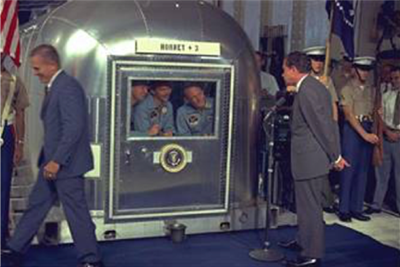 Another contingency had to do with the possibility of the astronauts bringing back some strange germs from the Moon that were not present on Earth. To prevent an epidemic, the astronauts were quarantined—isolated from everybody else—for three weeks. The picture on the left shows the three astronauts in their small isolation chamber—converted from a vacation trailer—on board the aircraft carrier USS Hornet. (The “Hornet + 3” sign is a joke indicating that the ship had three extra people on board.) The man outside the chamber speaking to the astronauts is President Nixon.
Another contingency had to do with the possibility of the astronauts bringing back some strange germs from the Moon that were not present on Earth. To prevent an epidemic, the astronauts were quarantined—isolated from everybody else—for three weeks. The picture on the left shows the three astronauts in their small isolation chamber—converted from a vacation trailer—on board the aircraft carrier USS Hornet. (The “Hornet + 3” sign is a joke indicating that the ship had three extra people on board.) The man outside the chamber speaking to the astronauts is President Nixon.
The Smithsonian has an excellent article about the Apollo 11 mission if you would like to learn more.
GRADES 9–12
An ancient philosopher (Ecclesiastes 1:9, to be specific) once observed that “there is nothing new under the sun.” In many ways he was right, but the landing on the Moon was definitely something new “under the sun.” Never before in human history had people ventured beyond their home planet.
Even so, the Moon landing was not completely without precedent. In later years, when people asked Neil Armstrong for historical parallels, he would refer to the expansion of Polynesian settlers across the Pacific Ocean. Having figured out how to navigate across wide stretches of open water, the Polynesians spread out across the south-western Pacific Ocean, discovering small islands and settling on them. Armstrong likened the stars scattered across the wide expanse of space to the islands scattered across the ocean.
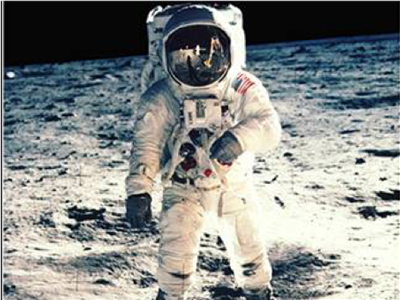 The parallel is not perfect, of course. Space is a much more hostile environment than the sea and the time of travel to other stars is much greater. On the other hand, can see the nearby stars—although we do not yet know what sort of habitable worlds they might have—while the Polynesians could not see the islands until they got fairly close to them. The Polynesian settlers left no written records, so we know very little about what they accomplished and how they did it.
The parallel is not perfect, of course. Space is a much more hostile environment than the sea and the time of travel to other stars is much greater. On the other hand, can see the nearby stars—although we do not yet know what sort of habitable worlds they might have—while the Polynesians could not see the islands until they got fairly close to them. The Polynesian settlers left no written records, so we know very little about what they accomplished and how they did it.
There is a community of conspiracy theorists who claim that the Apollo moon landings were faked. Refuting their claims can be an easy exercise in critical thinking. Based on a variety of small discrepancies, unanswered questions, and unknown phenomena, the conspiracy theorists claim that NASA faked the hardware, the photographs, and the testimonies of all those involved. (There are also jokers who make up stories about creating the hoax.)
Like most attempts to refute conspiracies, there is so much evidence that the Apollo astronauts actually walked on the Moon that the main question is where to begin the proof. The number of people, just from NASA, who would have to be involved for this to be true staggers the imagination. But the Moon landings were public events: people from around the world watched them happen. The Soviet government, which was locked in a race with the Americans to land somebody on the Moon, had its own equipment that it could use to listen to the transmissions of the astronauts; had the mission been a fake, the Soviets would have taken great delight in saying so—and saying it loudly. There are also the lower stages of the lunar landers and the other equipment that the Apollo astronauts left on the Moon. These things are still there and current lunar missions have photographed them. The conspiracy theorists say that NASA is faking their photographs, continuing the cover-up, but NASA is not the only agency that is photographing the Moon. If there were any possibility of a hoax, the Chinese and European space agencies could very easily expose it.
Once a single piece of confirming evidence has been found, there is no need to look for more. More evidence can be (and usually is) out there, but it is not necessary. That the Soviet Union did not denounce the Apollo missions as fakes at the time confirms that the missions took place as NASA says they did. No amount of “evidence” to the contrary will remove this confirmation and no further confirmation is necessary.
Sixty Years Ago in the Space Race:
July 20, 1959: NASA chose Western Electric to build a worldwide network of tracking and ground stations.
July 22, 1959: NASA selected the B.F. Goodrich company to manufacture the space suits for the Mercury program.
